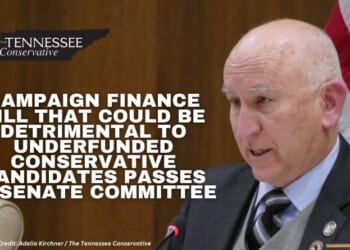IN THE first part of this interview, which we published before Christmas, former US State Department Cyber Division head Mike Benz explains the evolution of the post-war soft power international rules-based order that ended up authorising the military, the diplomatic sphere and the intelligence world to take control over social media.
In the second part, Benz starts to explain the scale of Donald Trump’s task of deconstructing the Deep State and its censorship ‘mercenaries’, not least because of the mutation of democracy into institutional consensus building and imposition, suiting these interests but no longer representing the will of the people. He continues this discussion using as an example of the US’s control over Ukraine’s supposed democracy in this third part.
The full interview is here and edited extracts of the second part follow below it.
MIKE BENZ: We can’t think of democracy as elections any more. For example, Ukraine has banned elections. We still say, ‘We are providing $300billion of military support to promote democracy in Ukraine, even though they don’t have elections.’ Well, it’s because [Ukraine is] controlled by US institutions. You can look at something called the Red Lines Memo, by the way, on my X account if you’re curious.
JOE ROGAN: When you say that Ukraine no longer has democracy. Essentially, what happened is Zelensky was supposed to leave office, and he did not. Is that what happened?
MB: Well, they’ve indefinitely cancelled elections. So he is . . .
JR: Because of the war?
MB: Because of the war, is their argument. Now, we had elections during the Civil War here in the US. This is not uncommon for countries to be at war and still have elections. The issue is, is that Zelensky is unpopular, and not winning in those election polls; and we no longer define democracy as being about elections, because elections allow populists to circumvent the consensus of institutions.
And if you want to see a great example of this, [it’s] the Red Lines Memo. And you will see, Zelensky’s first month in office, he was given a threat letter, effectively, by the US State Department, where they had something like 70 US-funded NGOs, who wrote a letter to Zelensky, telling him, ordering him, not to cross the below-listed red lines, ‘or else there will be political instability in your country’.
Now, political instability in a country caused by the US State Department is the reason Zelensky ultimately became president. The 2014 coup in Ukraine was US and UK-orchestrated political instability to have a January 6th-style mob destabilise the government and literally run it out of the country. And they gave him red lines on every single aspect of what he could do as president. Security red lines. Cultural red lines. Energy policy red lines.
JR: What were these red lines? Like, cultural red lines?
MB: So, for example, that he could not allow the use of Russian language to be aired on any of the major Ukrainian media channels. This was part of a drive by the US State Department – in tandem with the censorship work that started at that same time – in order to prevent the sort of affinity, the sort of Russian affinity network that happens because of Russian propaganda spreading from Russian language news sources. And to try to pry the country off of the Russian ethnic faction and have, essentially, the Ukrainian dialect . . .
JR: This is in response for what happened in Crimea?
MB: Yes. Yes. In Crimea and the Donbass, the whole eastern side breakaway. But this is effectively the long arm of Langley, the long arm of the State Department and CIA, telling Ukrainians that they can’t [speak Russian] – what kind of language they can use in their own country. Ukraine was effectively forced to transfer over its, you know, its education ministry to an EU commissioning body so that Russian-adjacent mythologies couldn’t be taught in the country. They were told what industries they needed to privatise and to block any attempt to maintain sovereign control of those energy assets. This is ultimately what gave rise to the Burisma scandal, by the way, and the Hunter Biden State Department affairs that ran through all of that, which is a whole other fascinating topic, I should add. But the fact is . . . every aspect of Ukrainian society is effectively top-down controlled by democratic institutions, funded by the US government when it’s stock standard that the only reason we do that – you know, he who pays the piper calls the tune – [is] they’re being funded to exert this soft power issue, this soft power force on the Ukrainian government.
And Zelensky knows that force. Because the only reason he occupies the power that he does is because that force ushered him in through the sequence of events from Yatsenyuk in 2014 up to him. And so the issue is, those are the institutions. By the way, that whole thing was run through something called the Ukraine Crisis Media Centre, which is effectively a suite of media institutions in the area that are CIA conduits, like the Kiev Independent, which is funded by the National Endowment for Democracy. The National Endowment for Democracy is one of the most pernicious forces in the entirety of the censorship industry. You were talking with Marc Andreessen about NGOs and their role in internet censorship. And you know, he was, I think, fleshing out sort of the concept of a GONGO – a government-organised non-governmental organisation.
The National Endowment for Democracy is sort of posited as an NGO. But it’s got a very curious history, again. This is what sponsors so much of the Ukrainian media. The National Endowment for Democracy was created in 1983 because of a dilemma that the new Ronald Reagan administration faced. The CIA, at that point in the early 80s, its name was dirt. There were the massive scandals in the 1960s to the 1970s – everything from Operation Mockingbird to MK-Ultra, to Operation Chaos, to literally bribing student groups on college campuses; all sorts of things. The heart-attack gun being held up in a public hearing at the Church Committee in 1975: about ways the CIA was assassinating world leaders and assassinating journalists and political figures using methods that included, you know, a gun that would make it look like they organically died of a heart attack. All of these things gave rise to Jimmy Carter being elected in 1976. He was not expected to win in ’76, but he won on the back of Democrat mass outrage over the malfeasance of the national security state, the CIA.
And so the following year, Carter does something called the Halloween Massacre. He fires 30 per cent of the CIA’s operations division in a single night. And then he totally cripples the CIA’s budget. Reagan gets to power after the Iran hostage situation, wants the CIA’s powers back. But the Democrats were still hugely hostile to it. The public still had not fully forgiven the CIA. And so they came up with a cute trick. And you can actually look at a September 1991 David Ignatius article called ‘Spyless coups’ – this is in The Washington Post. The article begins by saying that we don’t really need, even need, to nominate Robert Gates to the Senate, the new CIA Director . . . we don’t even need to do a Senate confirmation hearing for a CIA Director any more, because the CIA is effectively made obsolete by its new tactic that we use through NGOs spearheaded by the National Endowment for Democracy.
And you’ll find in that article, you know, a quote by the National Endowment for Democracy’s founder, Carl Gershman, where he explicitly says that it would be a terrible thing for groups supported by the US Government to be seen as subsidised by the CIA. We did that in the 1960s, and it worked out terribly for us when it turned out they were backed by the CIA. That’s why the National Endowment for Democracy was created, so that the CIA could effectively subsidise the groups without having CIA fingerprints on it.
You know, if you look at its legislative history where it passed, effectively, a Bill through Congress that Ronald Reagan approved, the origins of it come from the CIA director William Casey in 1983, working directly with the US Attorney General, as well as an entire USAid blueprint, the previous year.
The CIA requested this to be set up. It’s funded entirely by the US government. It’s officially accountable to the House Foreign Relations Committee and the Senate Foreign Relations Committee. So it’s funded by the government. It’s literally accountable to a US congressional committee. The CIA Director birthed it. The founder acknowledged that they were created to do what the CIA wants to do but gets in trouble for doing. And we call this an NGO? I don’t think so.
And so the issue is, is the National Endowment for Democracy and the entire intelligence community were the ones who led this conversion from counter communism to counter populism. They’re the ones that when Trump rose to power and when Brexit and the whole, you know, NATO/EU country domino started electing right wing populists who were hostile to the foreign policy establishment’s consensus – and a lot of this has to do with energy, geopolitics and military interventionism, and we can get to those if you want to go there. But the NED has its octopus arms around the entirety of the censorship industry.
If you want to see something really, really crazy, there’s a video that we can watch. It’s a two-minute from one of NED’s global censorship programmes, where they explicitly work with foreign governments to get foreign governments to pass censorship laws to attack US companies. So this is the US government funding a CIA cut-out to back-channel with regulators and influencers in foreign countries to get those foreign countries to crush US national champions in the tech space. This is the exact opposite of what the State Department was set up in 1789 to do.
(The video is then played at 41.35 minutes into the interview which readers should watch. The video’s aim is to provide a blueprint for ‘countering disinformation and promoting information integrity’ which it says are ‘necessary priorities for ensuring democracy’.)
The next parts of this extraordinary interview will follow next week.










